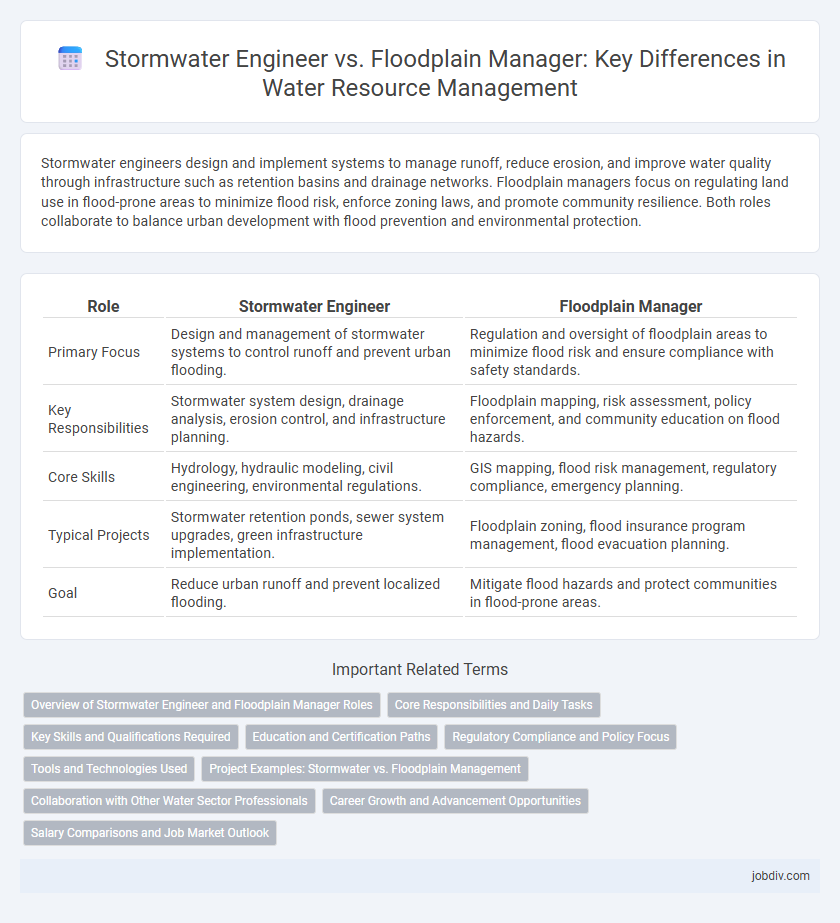Stormwater engineers design and implement systems to manage runoff, reduce erosion, and improve water quality through infrastructure such as retention basins and drainage networks. Floodplain managers focus on regulating land use in flood-prone areas to minimize flood risk, enforce zoning laws, and promote community resilience. Both roles collaborate to balance urban development with flood prevention and environmental protection.
Table of Comparison
| Role | Stormwater Engineer | Floodplain Manager |
|---|---|---|
| Primary Focus | Design and management of stormwater systems to control runoff and prevent urban flooding. | Regulation and oversight of floodplain areas to minimize flood risk and ensure compliance with safety standards. |
| Key Responsibilities | Stormwater system design, drainage analysis, erosion control, and infrastructure planning. | Floodplain mapping, risk assessment, policy enforcement, and community education on flood hazards. |
| Core Skills | Hydrology, hydraulic modeling, civil engineering, environmental regulations. | GIS mapping, flood risk management, regulatory compliance, emergency planning. |
| Typical Projects | Stormwater retention ponds, sewer system upgrades, green infrastructure implementation. | Floodplain zoning, flood insurance program management, flood evacuation planning. |
| Goal | Reduce urban runoff and prevent localized flooding. | Mitigate flood hazards and protect communities in flood-prone areas. |
Overview of Stormwater Engineer and Floodplain Manager Roles
Stormwater engineers design and implement systems to control and manage runoff from rain and storms, focusing on infrastructure like retention basins, drainage networks, and green roofs to reduce erosion and water pollution. Floodplain managers analyze flood risk areas, develop mitigation strategies, enforce regulations, and coordinate community planning to minimize flood damage and protect property and public safety. Both roles require expertise in hydrology, environmental regulations, and sustainable water management practices to address challenges posed by urbanization and climate change.
Core Responsibilities and Daily Tasks
Stormwater engineers design and implement systems to manage runoff, reduce erosion, and improve water quality through infrastructure like retention basins and green roofs. Floodplain managers analyze flood risks, enforce zoning regulations, and develop emergency response plans to minimize flood damage in vulnerable areas. Both roles collaborate on data collection and modeling but prioritize different aspects of water management: stormwater engineers focus on water flow control, while floodplain managers emphasize community safety and land use planning.
Key Skills and Qualifications Required
Stormwater Engineers require expertise in hydrology, hydraulic modeling, and civil engineering design to develop effective stormwater management systems. Floodplain Managers must possess strong knowledge of floodplain mapping, risk assessment, and regulatory compliance related to the National Flood Insurance Program (NFIP). Both roles demand proficiency in GIS technology, environmental regulations, and project management skills to mitigate water-related hazards efficiently.
Education and Certification Paths
Stormwater engineers typically require a degree in civil or environmental engineering and often pursue professional engineering (PE) licensure specializing in stormwater management. Floodplain managers usually have backgrounds in environmental science, geography, or urban planning, with certifications such as the Certified Floodplain Manager (CFM) credential from the ASFPM enhancing their expertise. Both roles emphasize continuous education in hydrology, flood risk assessment, and regulatory compliance to effectively design and manage water resources.
Regulatory Compliance and Policy Focus
Stormwater engineers design and implement infrastructure that manages runoff to meet environmental regulations such as the Clean Water Act, focusing on controlling pollutants and preventing erosion. Floodplain managers develop and enforce land-use policies aligned with the National Flood Insurance Program and local ordinances to reduce flood risks and ensure community resilience. Both roles collaborate to ensure regulatory compliance by integrating engineering solutions with policy frameworks aimed at sustainable water management.
Tools and Technologies Used
Stormwater engineers utilize advanced hydrologic and hydraulic modeling software such as SWMM and HEC-HMS to design stormwater management systems, incorporating GIS for spatial analysis and real-time sensors for monitoring water flow and quality. Floodplain managers rely on FEMA's Flood Insurance Rate Maps (FIRMs), geographic information systems (GIS), and remote sensing technologies to assess flood risks, enforce land-use regulations, and implement mitigation plans. Both roles increasingly adopt drone surveillance and AI-driven predictive analytics to enhance accuracy in flood forecasting and infrastructure resilience.
Project Examples: Stormwater vs. Floodplain Management
Stormwater engineers design and implement systems such as green infrastructure, detention basins, and permeable pavements to control runoff and reduce urban flooding, exemplified by projects like municipal stormwater retrofit programs. Floodplain managers focus on land-use planning, regulatory compliance, and risk assessment to mitigate flood hazards, as seen in initiatives like floodplain mapping updates and community floodplain zoning enforcement. Both roles collaborate on integrated watershed management efforts to enhance resilience against flooding and improve stormwater quality.
Collaboration with Other Water Sector Professionals
Stormwater engineers collaborate closely with floodplain managers to design infrastructure that effectively controls runoff and mitigates flood risks. Their teamwork ensures integration of hydraulic models and land use planning for resilient water management strategies. Coordinated efforts with hydrologists, urban planners, and environmental scientists enhance the sustainability of stormwater systems and floodplain development.
Career Growth and Advancement Opportunities
Stormwater engineers specialize in designing and implementing systems to manage runoff and improve water quality, with career growth often linked to expertise in infrastructure and environmental compliance. Floodplain managers focus on risk assessment, land use planning, and regulatory enforcement to mitigate flood hazards, advancing through roles in emergency management and policy development. Both careers offer pathways to leadership in environmental consultancy, government agencies, and sustainable urban planning sectors.
Salary Comparisons and Job Market Outlook
Stormwater engineers typically earn salaries ranging from $70,000 to $100,000 annually, reflecting their expertise in designing and managing urban drainage systems, while floodplain managers often have salaries between $60,000 and $90,000, focusing on flood risk assessment and regulatory compliance. The job market for stormwater engineers is growing due to increasing infrastructure investments and climate change mitigation efforts, whereas floodplain managers see steady demand driven by evolving floodplain regulations and hazard mitigation programs. Both roles require specialized knowledge in hydrology and environmental policy, but stormwater engineers may have broader opportunities in civil engineering firms and municipal projects.
Stormwater Engineer vs Floodplain Manager Infographic

 jobdiv.com
jobdiv.com